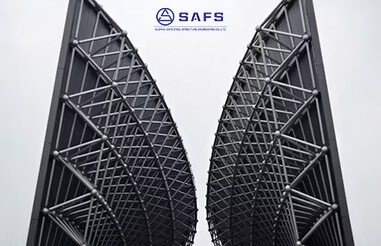Dapeng Town Industrial Park, Tongshan District, Xuzhou City, Jiangsu Province, China
Below are three potential risks associated with space frame structures along with corresponding maintenance strategies:
1) Fire Risk:
Due to its poor thermal resistance characteristics coupled with significant property alterations at temperatures ranging from 430-540°C—resulting in a sharp decline in yield point values as well as tensile strength—the load-bearing capacity of steel diminishes considerably under these conditions; hence necessitating extensive research into employing fire-resistant materials for maintaining steel structures effectively against such hazards.
The catastrophic structural failure witnessed globally was attributed to a conflagration incident; however mitigating similar occurrences encompasses multifaceted considerations where conventional methods like applying fire-retardant coatings or utilizing sprinkler-based firefighting systems appear inadequate.
2) Instability Hazard:
a) Both global instabilities alongside localized instabilities predominantly stem from localized issues wherein exceeding permissible long-to-diameter ratios within compressive or bending components leads to loss of stability—a phenomenon influenced by diverse external factors including variations in loads as well as inherent material flaws within steel besides distinct support configurations frequently overlooked during design/construction phases contributing significantly towards global instabilities.
b) During lifting operations involving trusses/space frame structure elements positioned at varying lift points can induce disparate forces thereby triggering instances of instability leading to collapses/deformations primarily attributable to insufficient bracing elements coupled with inadequate support mechanisms.

3) Corrosion Risk:
Commonplace steels exhibit subpar anti-corrosive attributes particularly when exposed to high humidity environments featuring corrosive agents resulting in rapid deterioration that compromises member carrying capacities substantially—an exemplar being observed corrosion rates averaging between 0 .10-0 .16mm annually on roof trusses within converter plants worldwide; further statistics reveal annual losses accounting for approximately 30%-40% pertaining to global steel production due to corrosion-related factors culminating in net losses nearing 10%.
A comprehensive analysis encompassing accidents involving varied types (e.g., wooden/steel-space hybrid variants) revealed that collapses linked specifically to steel space frame accounted for nearly 38 .62%, attributing a substantial proportion thereof directly towards corrosion-induced degradation compounded by lackadaisical maintenance practices.”